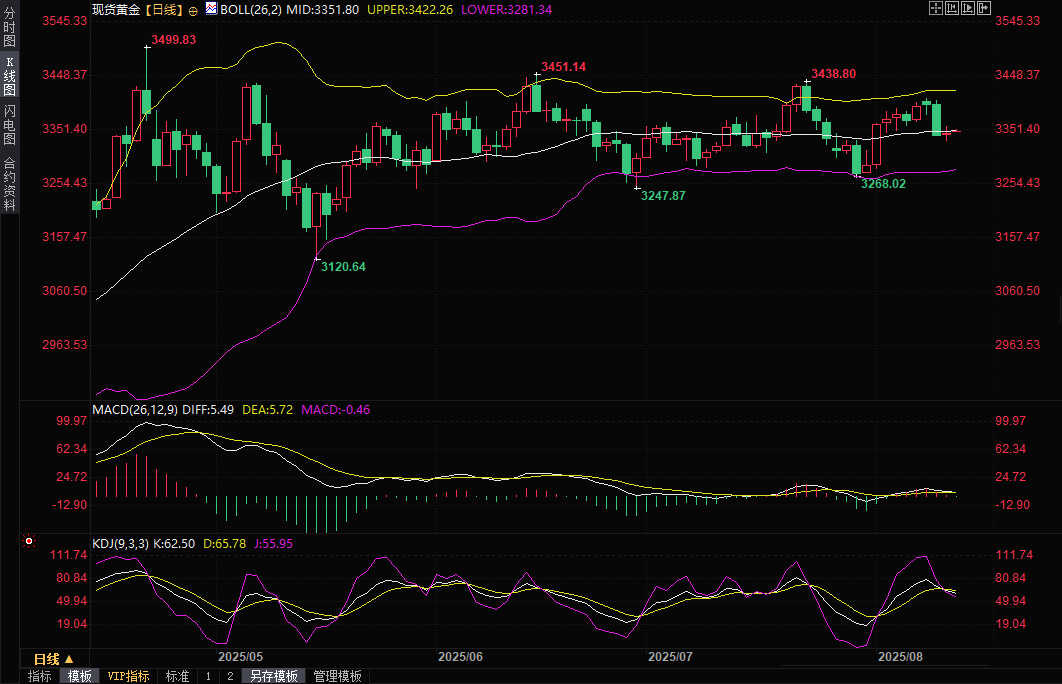Gold trading reminder: US inflation is mild, signaling a rate cut, bulls are ready to move, and attention should be paid to the speeches of Fed officials.
2025-08-13 07:42:06

Inflation data moderately relieves pressure, and gold's safe-haven appeal begins to emerge
The U.S. Consumer Price Index (CPI) rose 0.2% month-over-month in July, reaching a 2.7% year-over-year increase, broadly in line with market expectations but slightly below some economists' forecasts. This data, following a 0.3% increase in June, suggests easing inflationary pressures. In particular, the core CPI (excluding food and energy) rose 0.3% month-over-month and 3.1% year-over-year, the largest increase since January this year, though overall, it did not show a significant upward trend.
Bob Haberkorn, market strategist at RJO Futures, noted that this inflation performance was "mixed," but sufficient to support the Fed's path of rate cuts. The tame inflation trend has eased market concerns that tariffs could push up prices. While the Trump administration has repeatedly emphasized the impact of tariffs, data shows their transmission effect is limited. This has provided support for gold, as investors are more inclined to shift funds to gold as a hedge against potential economic downturns when inflation remains within control.
In contrast, gold could face short-term pressure if inflation unexpectedly surges, but the current data has consolidated its position as a safe-haven asset, attracting buyers holding other currencies, especially as a weaker dollar further reduces the cost of buying gold.
Gold bulls are confident as Fed rate cut expectations rise
The release of inflation data directly strengthened the market's bets on the Federal Reserve's interest rate cut in September.
According to CME Group's FedWatch tool, traders increased their probability of a rate cut at the September 16-17 meeting to 94% from 86% on Monday. This expectation stems from continued weak employment data - fewer jobs were added in July than expected and data for previous months were significantly revised downward - combined with stable inflation, which provides the Fed with ample policy space.
Karl Schamotta, chief market strategist at Corpay, emphasized that underlying inflation remains subdued, which leaves room for maneuver to address signs of labor market weakness. He further predicted that Federal Reserve Chairman Powell will explicitly mention the possibility of a September rate cut at the Jackson Hole Economic Symposium later this month.
For gold, the expectation of a rate cut is a strong catalyst, as lower rates weaken the dollar's appeal and reduce the opportunity cost of holding gold. Historically, gold prices have tended to rally whenever the Federal Reserve enters an easing cycle. Following the release of this data, traders maintained their bets on rate cuts in September and December, bolstering bullish momentum for gold, although the market remains cautious in the short term, awaiting further confirmation from economic indicators.
Gold prices rise as dollar weakens
The US dollar index fell across the board after the inflation data was released, hitting an intraday low of 97.89, the lowest since July 28. This weakness directly benefited from the support for interest rate cut expectations from moderate inflation, and was also affected by the dual influence of the Reserve Bank of Australia's interest rate cut expectations and strong UK employment data.
Forex analyst Fawad Razaqzada analyzed in a report that if the Federal Reserve continues to cut interest rates, the interest rate differential between the US dollar and high-yielding currencies will rapidly narrow, putting pressure on the US dollar exchange rate. For gold, a weaker dollar means that gold denominated in other currencies becomes cheaper, stimulating demand from international buyers. Globally, the largest increase since October, but overall, there has not been a significant upward trend.
Bob Haberkorn, market strategist at RJO Futures, noted that this inflation performance was "mixed," but sufficient to support the Fed's path of rate cuts. The tame inflation trend has eased market concerns that tariffs could push up prices. While the Trump administration has repeatedly emphasized the impact of tariffs, data shows their transmission effect is limited. This has provided support for gold, as investors are more inclined to shift funds to gold as a hedge against potential economic downturns when inflation remains within control.
In contrast, gold could face short-term pressure if inflation unexpectedly surges, but the current data has consolidated its position as a safe-haven asset, attracting buyers holding other currencies, especially as a weaker dollar further reduces the cost of buying gold.
The US-China tariff truce is extended, giving the gold market a breathing space
The United States and China extended their tariff truce for 90 days to November 10, avoiding significant tariffs on each other's goods. Although this news was largely ignored by currency markets, it injected stability into the gold market.
Reports that Washington would impose tariffs on imported gold bars had pushed U.S. gold futures to a record high last Friday, but Trump's statement on social media that no tariffs would be imposed caused gold prices to fall by more than 2% on Monday. The decision to extend the truce has now eased trade tensions and reduced the potential risk of rising inflation.
Matt Bush, a U.S. economist at Guggenheim Investments, said the inflation data showed limited tariff transmission, telling us the Fed's 2% inflation target is on track.
Richmond Fed President Barkin warned that active consumer purchases could mitigate the impact of tariffs on inflation, but could also trigger a cycle of falling demand and rising unemployment.
For gold investors, the extension provides valuable breathing space, avoiding market panic caused by an escalating trade war in the short term, while enhancing gold's appeal as a hedge against geopolitical risks.
Market outlook
Although in the short term the market will focus on this week's PPI, unemployment benefits and retail sales data, in the long term, the Federal Reserve's loose policy and geopolitical uncertainties will continue to support gold's upside potential.
In addition, this trading day will see speeches by Richmond Fed President Barkin, Chicago Fed President Goolsbee, and Atlanta Fed President Bostic, which investors need to pay attention to.

(Spot gold daily chart, source: Yihuitong)
At 07:40 Beijing time, spot gold was trading at $3351.39 per ounce.
- Risk Warning and Disclaimer
- The market involves risk, and trading may not be suitable for all investors. This article is for reference only and does not constitute personal investment advice, nor does it take into account certain users’ specific investment objectives, financial situation, or other needs. Any investment decisions made based on this information are at your own risk.





















